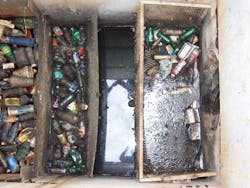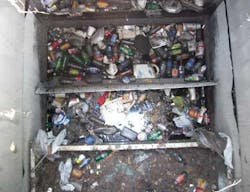| Pond with trash and nutrients built up. |
While these are clear physical limitations, there are more subtle challenges that exist for lab-tested BMPs. In a laboratory, the size and concentration of the particles fed into the BMP is strictly controlled and consistent. In nature, however, the material entering the BMP is variable from moment to moment, both in particle size and in concentration. In the laboratory, the particles fed into the BMP are typically silicon dioxide-based material with a relative density of 2.65. In the field, we know that the average density of the material captured by BMPs has proven to be about 1.70, and it consists of materials that vary from heavy metals — such as wheel weights — to natural sands, silts and clays, to plastics, trash and organics, to very light floating materials such as Styrofoam beads. While the laboratory measures performance (and sediment retention) at steady flow rates, natural flow rates vary greatly from moment to moment and from storm to storm. Laboratory testing is a good thing but it should not be mistaken for reality, nor should a "percentage of removal" be assigned based strictly on laboratory results.
The State of the Art
Today, we define the removal of solids as a surrogate for actually controlling pollution. We choose to trust testing to "verify" the performance of BMPs. Testing certainly does give some indication of what a BMP may or may not do but the real answer to their effectiveness is right at hand. All we need to do is look in the BMPs once they have been in service for awhile.
We will see ponds that are impacted with excessive sediments and are full of trash. Standing pools that are supposed to draw down in 24 to 72 hours will appear semi-permanent, full of algae, mosquitoes or invasive plants. They may be contaminated with hydrocarbons or other noxious materials. We may see a manufactured vault with an trash rack or clogged filters. Believe it or not, these observations are actually good news overall: the pond is capturing sediments and trash; nutrients and oil are being intercepted; a manufactured vault can have its contents removed and be like new. Almost all of these "failures" can be corrected by cleaning and maintenance. The bottom line is that if we simply look at what we are doing and diligently record the results, we will quickly see what works and what does not.
About the Author: John Moll is the CEO of CrystalStream Technologies and is an active researcher in the water quality field. He holds eight water quality-related patents, and has incorporated a maintenance company into CrystalStream that has provided invaluable data about actual field performance of BMPs.








